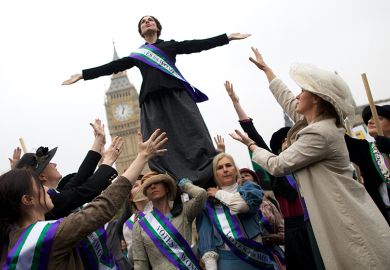This is an accomplished and scholarly biography of a compelling individual. It is also a literary life that throws much light on the Augustan world of letters. Furthermore, this study carries conviction in part because Isobel Grundy does not exaggerate the importance of her subject. As a result, her book is more convincing than the last biography of an 18th-century figure I was asked to review for The THES , Amanda Foreman's Georgiana: Duchess of Devonshire .
The difficulties of navigating a personal life and literary career in a world dominated by men and their suppositions bulk large in this study. They also affected the response to Lady Mary Wortley Montagu's support for inoculation against smallpox. Born into the high nobility - her father was raised to a dukedom - Lady Mary had, however, early on to cope with deaths in her immediate family and then was exposed to a marriage market where the choices, in her eyes, were those of paradise, limbo and hell. Paradise was out of her reach, and although she was nearly forced to marry her father's choice - hell - she instead eloped with limbo, Edward Wortley Montagu.
Theirs was to be an uneasy relationship from the outset, and part of the skill of Grundy's study lies in the way in which she charts its long history and impact. The role of chance also emerges clearly. Had she married the choice of "the disposer of me" (her father), the much disliked Clotworthy Skeffington, Lady Mary would not have gone to Constantinople nor, possibly, enjoyed comparable opportunities to write about the court.
Montagu was appointed ambassador to Constantinople in 1716 and Grundy provides a fine account of the embassy. Lady Mary was an observant and responsive traveller. She was, for example, most impressed by what is now termed belly dancing: "Nothing could be more artfull or more proper to raise certain Ideas, the Tunes so soft, the motions so Languishing, accompany'd with pauses and dying Eyes, halfe falling back and then recovering themselves in so artfull a Manner that I am very positive the coldest and most rigid Prude upon Earth could not have look'd upon them without thinking of something not to be spoke of."
Returning home in 1718, Lady Mary resumed the social whirl while her husband spent much of the following two decades developing his Tyneside coal interests. Lady Mary seldom or never went with him to Tyneside. Instead, she had time to cultivate a wide variety of friendships whose course Grundy charts. Most famous was Alexander Pope, although he was far from alone among literary friends. It was Pope who commissioned from Sir Godfrey Kneller the portrait of Lady Mary wearing modified Turkish costume that hung in his "Best Room Fronting the Thames" until his death. Pope was delighted by the painting but lamented the impossibility of rendering her inner qualities: learning, wisdom, the "Soul Divine".
This was the period when Lady Mary was pressing the winning case for inoculation, and, as a consequence, winning Voltaire's praise, while enjoying society gossip. Grundy performs a superb job of tracing her subject's path through society and her related literary networks. Her poems of the 1720s are carefully linked to their contexts. So also are the attacks on Lady Mary. An obsessive Pope presented her as promiscuous, although Grundy is unconvinced. She suggests that the friendship between Lady Mary and Pope was problematic even in its earliest phase, 1715-18, and that, from the outset, Pope had less control over his feelings than he would have liked. Addison allegedly warned her against Pope. His negative feelings about her went immeasurably beyond his other enmities.
Aside from Pope, Grundy asks the question why Lady Mary's style attracted the repressive censure she frequently complained of. In cracking jokes about forbidden subjects and choosing or wearing clothes in a manner that gave offence she repeatedly tested bounds.
Her writings had a similar effect, although a large amount of what she wrote does not survive, in part because she herself destroyed much. This was an aspect of the struggle of her life. Lady Mary sought not so much to be accepted, but to express herself, and her ideas were highly original and, on issues of gender, radical. She was hostile towards mores governing the position and conduct of women, both marriage law and attitudes to non-marital sex.
In 1736 Lady Mary fell in love with a much younger Italian, Francesco Algarotti, and when he returned to Italy that year he left her on edge. This did not prevent her from putting much of her energy into writing, especially for the journal, the Nonsense of Common-Sense. Lady Mary was not the first woman to write in a periodical but the newspaper did not last long. It did, however, allow her to write in defence of women. Grundy offers a fine account of her ideas.
In 1739, with her closest friends in London dead, and her relations with her husband and children poor, Lady Mary set off for Italy, in pursuit of Algarotti. Her long years in Italy and Avignon are followed with care. Contacts and health, books and places are all discussed at length, although the text is less crowded than for the London years. In 1762, when she returned home, it was to a very different London scene. Her son-in-law, the earl of Bute, was now first minister. Suffering from culture shock and missing Venice, Lady Mary succumbed to cancer.
Grundy's fine study ends with the subsequent fate of the papers. An already-long book alas does not have space for a consolidated consideration of Lady Mary as writer and public figure. This is a pity, but there is still a wealth of information and reflection, and a careful piecing-together of a fascinating life.
Jeremy Black is professor of history, University of Exeter.
Lady Mary Wortley Montagu: Comet of the Enlightenment
Author - Isobel Grundy
ISBN - 0 19 811289 0
Publisher - Oxford University Press
Price - £30.00
Pages - 703
Register to continue
Why register?
- Registration is free and only takes a moment
- Once registered, you can read 3 articles a month
- Sign up for our newsletter
Subscribe
Or subscribe for unlimited access to:
- Unlimited access to news, views, insights & reviews
- Digital editions
- Digital access to THE’s university and college rankings analysis
Already registered or a current subscriber?



